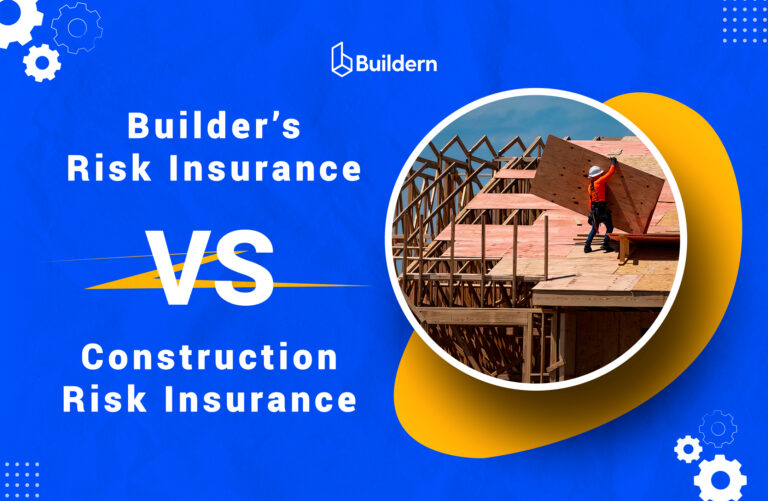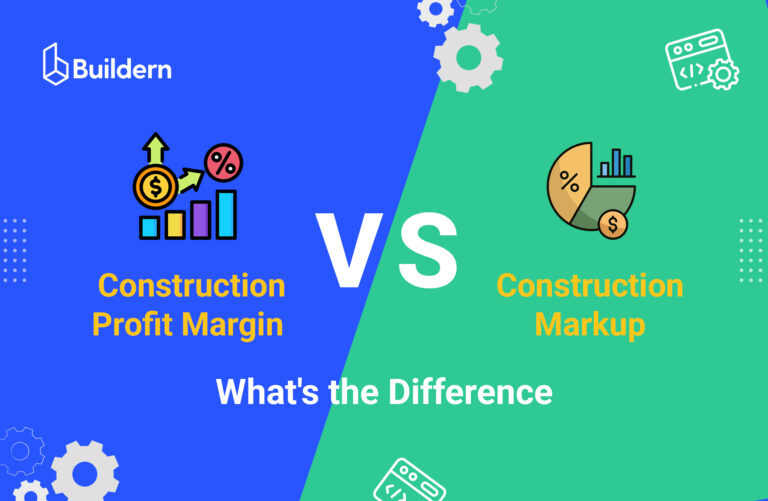Modern Construction Bidding Process: From Strategy to Submission
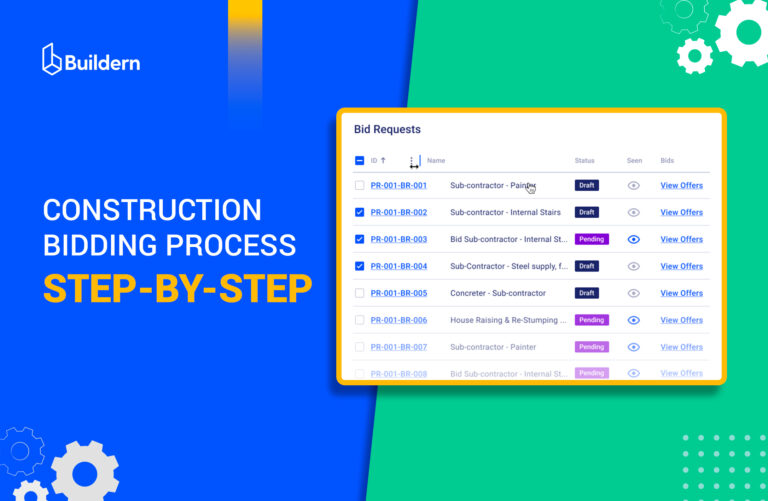
What’s the cost of sending out a bid package without knowing whether the numbers will hold up?
For many builders, the answer is measured in both money and time, influenced by factors like subcontractor quotes arriving later than expected or vendor pricing changing halfway through estimating. Therefore, the construction bidding process remains one of the key considerations in effective cost tracking workflows. It serves as the point where accurate estimating, supplier coordination, and clear communication come together to set the financial tone for the entire project.
Our article walks through what a modern, well-structured construction bidding process looks like in practice. You’ll see how bid requests help secure timely, accurate numbers from subcontractors and suppliers, and how those figures shape the client proposal.
Table of Contents
- Overview of the Construction Bidding Process
- Key Elements of a Construction Bid
- 5 Core Stages of the Construction Bidding Process
- Tips to Send Professional Bid Requests to Your Partners
- How an Online Platform Beats Email and Outdated Methods

Overview of the Construction Bidding Process
The construction bidding process is a structured approach to collecting prices from subcontractors, vendors, or suppliers for a defined scope of work. Those figures flow directly into the builder’s estimate and play a critical role in setting the final project cost through client proposals.
That said, bids and proposals, though often used interchangeably, serve different purposes:
- Bids are what builders request from subcontractors or vendors. These are detailed, line-by-line pricing quotes tied to specific trades, materials, or services.
- Proposals are what the client receives. They combine the full project scope, compiled pricing, schedule, and terms based on the builder’s completed estimate (including the approved bid requests).
Bid requests are usually prepared early in the estimating stage. By securing subcontractor and supplier pricing upfront, the builder works with real numbers instead of assumptions. This approach improves accuracy, shortens turnaround time, and strengthens client confidence in the proposal.
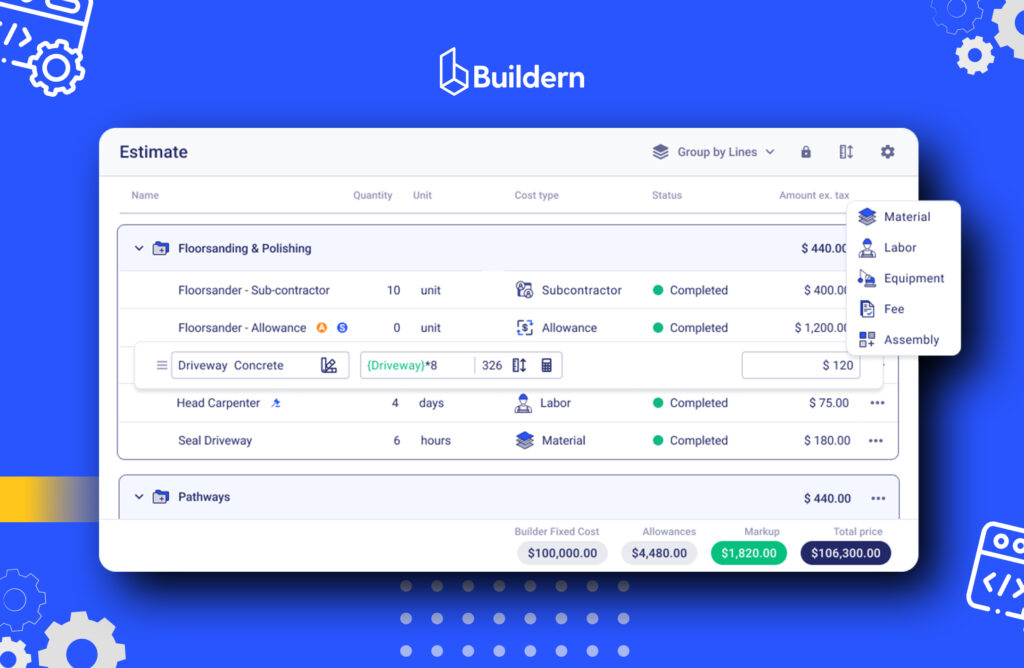
Key Elements of a Construction Bid
A construction bid should give the builder a complete picture of the work to be done, how it will be done, and at what cost. The best bids remove uncertainty, allowing the builder to make quick, informed budget calculations.
Although formats vary from trade to trade, strong bids generally include:
- Scope of Work: Defines exactly what the bidder is responsible for. For instance, a masonry contractor might detail block type, mortar mix, and wall height. This clarity protects both sides from scope gaps.
- Materials and Labor: Lists the materials supplied by the bidder and explains how labor is calculated. If exclusions exist, such as a certain insulation grade or specialty fixture, they should be stated before the job starts.
- Timeline or Duration: Outlines the anticipated start and finish dates along with any dependencies. A drywall team, for example, may note that finishing work depends on stable interior humidity.
- Cost Breakdown: Separates pricing by trade, material type, or service category. When aligned with the builder’s cost coding system, these numbers integrate directly into the estimate without extra formatting.
- Inclusions and Exclusions: States what’s covered in the bid and what’s excluded. A landscaping contractor might include topsoil and planting, but leave irrigation installation to another trade.
- Terms and Conditions: Describes payment schedules, retention amounts, warranty terms, and any penalties for delays. While these points can be refined later in contract negotiations, documenting them early avoids misunderstandings.
When all these elements are present, the builder sees more than a bottom-line figure. They get a better understanding of how the work will fit into the schedule, the budget, and the overall project plan. That level of clarity often prevents delays and cost disputes once construction is underway.
5 Core Stages of the Construction Bidding Process
1. Bid Solicitation
The process starts by getting the right information into the right hands.
A well-prepared request gives subcontractors and suppliers the details they need to return accurate pricing. On some jobs, this involves full drawing sets, specifications, and recent site photos. On others, a shorter document followed by an in-person walk-through works better.
What matters most is clarity.
Subcontractors can work with what you give them, so the more complete the requirements, the better the results.
Depending on the job, that RFQ (request for quote, same as the bid request) might include:
- Pitch measurements and flashing details for the roofing crew.
- Fixture layouts for the plumbing team to estimate labor and materials.
Before any requests go out, it’s worth taking a few minutes to screen bidders. Check licenses, insurance, and past project experience. This quick step prevents wasted time on companies that can’t meet project requirements. When solicitation is rushed, gaps in scope or mismatched formats appear, and it becomes harder to compare responses side by side.
2. Submission
Once requests are in circulation, the replies arrive in waves.
Some bidders deliver neat, itemized spreadsheets tied to cost codes. Others provide only a total figure with little explanation. A few will send something that requires a follow-up call before it makes sense.
Setting a clear submission format from the start makes the review stage much smoother. Builders who use a dedicated construction bidding platform can bypass many of the headaches that come with messy, inconsistent responses. Instead of having subcontractors build their own spreadsheets, you can provide them with a ready-made structure.
All they need to do is enter their proposed costs.
If something needs clarification, those within your system can open RFIs directly, keeping questions and answers tied to the right bid package. Even subcontractors who don’t have full platform access can still communicate easily by email, with every message and submitted cost automatically stored in the same system.
Staying on top of responses is key. Track:
- Who has submitted
- Who still owes a reply
- What details are missing
Reaching out halfway through the submission period can fix issues before they snowball. A quick clarification now can prevent a scope misunderstanding later, especially once schedules are locked and procurement begins.
3. Selection
Choosing a winning bid involves more than looking at the final price.
A price that looks good at first can turn costly if it leaves key items out or comes from a crew with a history of delays. Therefore, many builders run a bid leveling exercise at this stage.
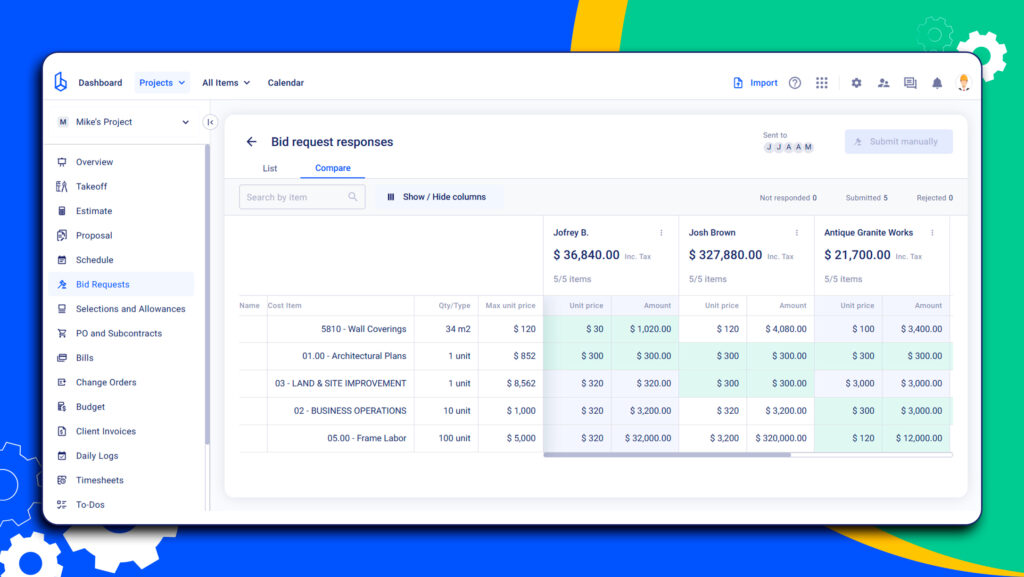
Each bid is adjusted so that the scope, quantities, and unit pricing align. This method reveals where one bidder excluded prep work or where another’s material cost seems unusually low. Such differences are easier to address before the contract stage than after mobilization.
Past performance can carry as much weight as price. A subcontractor who consistently delivers on time and meets quality benchmarks may edge out a slightly cheaper competitor. The aim is to select a partner who will hold up their end from the first day on site to the final handover.
4. Contract Negotiation and Formation
Once bid leveling is complete and you’ve chosen the subcontractors that best fit the project, it’s time to put the agreement in writing. Consider clarifying every detail regarding big decisions like the schedule, payments, and the overall scope of work.
It’s worth having project managers and estimators review the draft contract before signatures go on paper and into the client proposals. For multi-phase projects, the contract should also identify clear start and completion points for each phase.
Of course, at this stage of construction bidding, you may have endless questions and back-and-forth discussions with subcontractors. Keeping all of that communication in one place is essential.
Relying on scattered email threads or quick messages in a chat app makes it far too easy for important details to get buried, or worse, forgotten entirely. Those missed points can turn into costly misunderstandings once work is underway.
Therefore, using a platform with built-in RFI capabilities and a flexible messaging system is a smart move. It keeps every question, answer, and document tied directly to the right project and contract. Nothing gets lost, and everyone stays on the same page from negotiation through to completion.

5. Project Delivery
At this stage, the plans finally leave the paper and turn into real work on the job site. Crews, equipment, and materials are coordinated to match the schedule set in earlier stages. At this point, your role shifts toward active oversight. Being present on the site and catching issues early can make all the difference. Late deliveries, a trade falling behind, or installations that don’t match the drawings are far easier to fix when spotted quickly.
To keep the delivery stage on track:
- Monitor progress against the agreed schedule
- Coordinate deliveries to match installation timelines
- Address deviations immediately to protect the budget and deadlines
- Keep communication with subs and clients clear and regular
Using a dedicated subcontractor portal brings structure to what can otherwise be a chaotic stage. All communication, documents, schedules, and change requests are stored in one place, tied to the right project and trade. Your subcontractors can log in to access the latest drawings and schedules, confirm delivery dates and work sequences, and submit RFIs when needed.
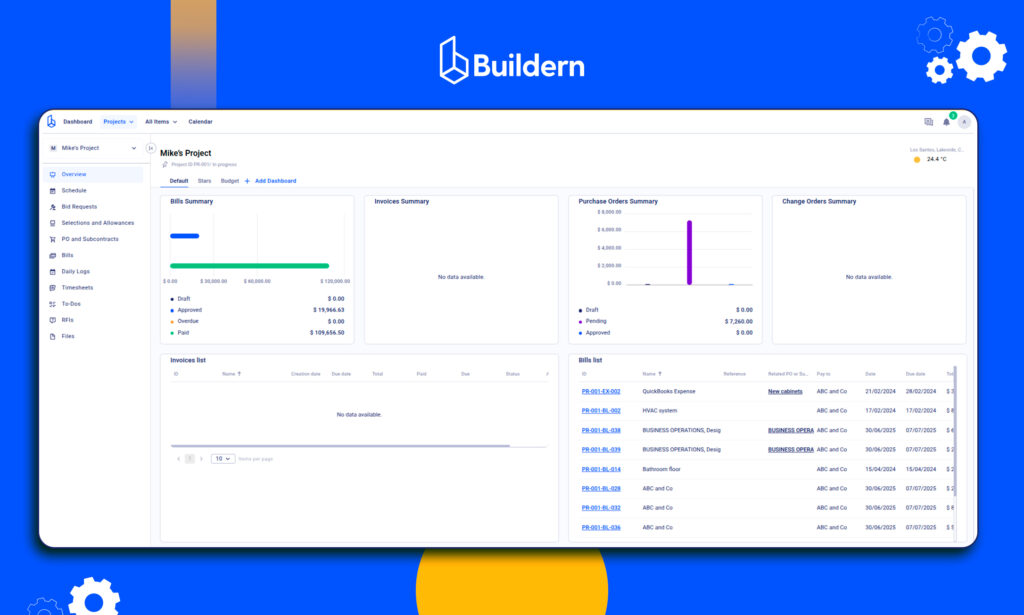
When the delivery stage runs smoothly, it’s a sign that every earlier decision from bid solicitation to contract formation was sound.
Tips to Send Professional Bid Requests to Your Partners
Sending out a bid request is often the first sign to your partners that the project is organized and worth their time. When that request is complete, clear, and easy to read, the responses come back faster and with fewer gaps. When it’s rushed, the questions start rolling in, and so do the delays. That’s why it helps to look at your bid package through the bidder’s eyes.
Ask yourself:
- Do they have enough drawings to picture the job?
- Are the specifications detailed enough to price without calling you back?
The more you can answer before they ask, the smoother your own review process will be. Here are some ways to strengthen your bidding process.
Provide Complete Drawings, Specifications, and Site Photos
Bidders need context to price accurately.
Supplying them with full drawing sets and current job site photos reduces the uncertainty and ensures everyone works from the same information sources.
Without this, subs may make their own assumptions, leading to inconsistencies that are hard to compare later.
Break the Scope into Logical Sections That Match Your Cost Codes
Organizing the scope in line with your cost codes makes it easier for bidders to complete their pricing and for you to review it later.
Clear segmentation prevents missed items and simplifies bid leveling when the responses come in. This way it will be easier to integrate your bid requests with the existing estimate and present realistic costs to the client.
Highlight Special Conditions Early
If there are unusual delivery restrictions, material storage limitations, or items with long lead times, note them in the request. Being upfront allows subs to adjust their pricing and schedule accordingly, reducing the chance of scope changes or delays later.
Check In Before the Deadline
Tracking the bid request status for mid-way check-in helps confirm that each bidder has received your request and understands the scope the same way.
It’s a chance to answer questions, resolve discrepancies, and ensure no one is missing critical details. This simple step can save hours during review and reduce the risk of costly misunderstandings.

How an Online Platform Beats Email and Outdated Methods
Manually comparing bids is harder than it sounds. One comes in as a spreadsheet with neat columns, while another is a PDF with a few lines and a total. Before you can even think about which one is better, you’re retyping and reformatting just to make them comparable.
That’s why bid leveling is so valuable. When every bid follows the same structure, it’s much easier to see where one sub left out a task or another priced a material higher than expected. Side-by-side comparisons bring these gaps into focus before the decision is made.

Construction project management software with such capabilities takes the same idea and builds efficiency around it. Responses land in a consistent layout, cost lines match your coding system, and totals are calculated without you touching a calculator.
Instead of wrestling with file formats, you’re making a decision based on a fair, accurate view of the numbers. That kind of clarity can save days off the selection process and cut down on costly surprises later.
What Is a Hard Bid in Construction?
A hard bid is a straightforward but high-stakes way to price a project. The owner or general contractor provides a complete set of plans and specifications, and contractors submit their final price by a fixed deadline. Bids are opened together, and the contract usually goes to the lowest qualified offer.
There’s no opportunity to adjust numbers afterward, so every figure needs to be checked and justified during estimating. You’ll see this approach often on public projects or large commercial builds where rules require competitive, transparent selection.
What Are the 5 Steps in the Process of Bidding?
Most projects follow a similar path from first invitation to the start of work:
- Bid Solicitation: Sending out the scope, drawings, and requirements to the right subcontractors and suppliers.
- Submission: Receiving their offers, each with its own breakdown and timeline.
- Selection: Comparing the bids, leveling them so the scope matches, and weighing factors beyond price.
- Contract Negotiation and Formation: Finalizing scope, cost, and delivery terms in writing.
- Project Delivery: Breaking ground and tracking progress against the commitments in the contract.
How Long Should the Bidding Window Be?
The experience shows most trades need at least one to two weeks to prepare a complete bid. More complex scopes that include structural steel, mechanical systems, or specialty finishes can benefit from two to three weeks. Too short a window forces bidders to guess on details, which means more questions and revisions later. A bit of extra time at the start usually pays for itself in better, more reliable pricing.
